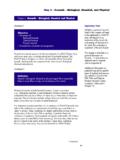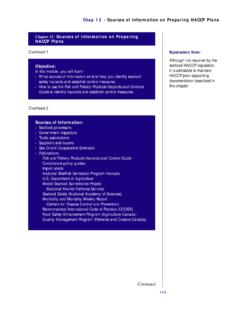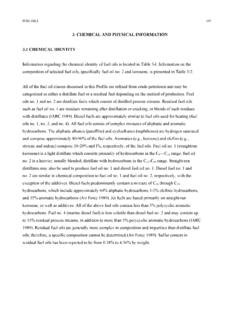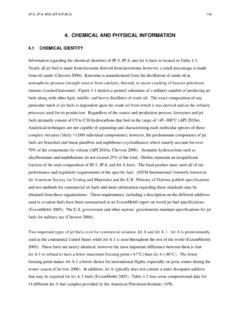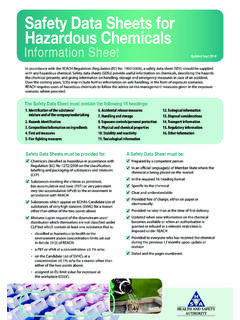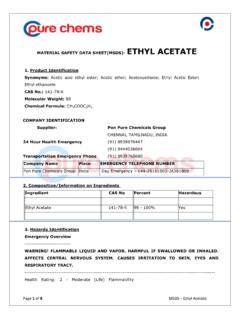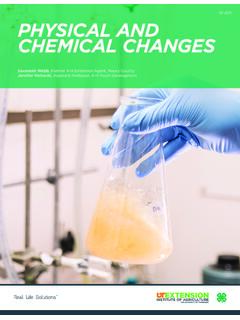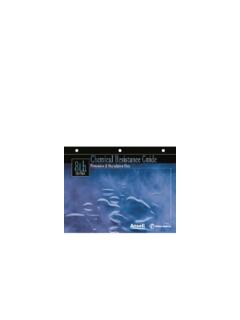Transcription of Notes: Chapter 7: Principle 3: Establish Critical Limits ...
1 Chap 7 - Principle 3: Establish Critical Limits73 ContinuedChapter 7: Principle 3: Establish Critical LimitsOverhead 1 Critical Limits must be established for each CCP identified in the 2 Overhead 3A Critical limit represents the boundaries that are used to ensure that anoperation produces safe products. Each CCP must have one or morecritical Limits for each food-safety hazard. When the process deviatesfrom the Critical limit, a corrective action must be taken to ensure foodsafety. Examples of Critical Limits are listed in Table Critical LimitsIn many cases, the appropriate Critical limit may not be readily apparentor available.
2 Tests may need to be conducted or information gatheredfrom sources such as scientific publications, regulatory guidelines, expertsor experimental studies (Table 2).Objective:In this module, you will learn: How to define Critical Limits . How to set Critical Limits for a CCP. How to find sources of Critical limit information . How to determine the relationship between Critical limitsand operating 3: Establish Critical : Critical Limit: A maximum and/or minimum value to which abiological, chemical or physical parameter must be controlled at aCCP to prevent, eliminate or reduce to an acceptable level theoccurrence of a food-safety :Chap 7 - Principle 3: Establish Critical Limits74 Overhead 4 Overhead 5If the information needed to define the Critical limit is not available,a conservative value should be selected.
3 The rationale and referencematerial used to Establish a Critical limit should become part of thesupport documentation for the HACCP a variety of options exist for controlling a particular hazard. Thecontrol options usually necessitate the establishment of different criticalTable 1. Examples of Critical LimitsHazardCCPC ritical Limitbacterial pathogenspasteurizer 161 F for 15 seconds for elimination of pathogens from milk(biological)bacterial pathogensdrying ovenDrying schedule oven temperature: 200 F, drying time:(biological) 120 min.
4 , air flow rate: 2 cuft/min, product thickness: (to achieve aw to to control pathogens in dried foods)bacterial pathogensacidificationBatch schedule product weight: 100 lbs., soak time: 8 hrs.,(biological)acetic acid concentration: percent, volume 50 gal. (to achievemaximum pH of to control Clostridium botulinum in pickled foods)Explanatory Note:These Critical Limits are forillustrative purposes only. Theydo not relate to any specificproduct but demonstrate howcritical Limits could apply atCCPs utilizing different controlparameters for bacterialpathogens.
5 In actual practice, Critical Limits must be scientifi-cally 2. Sources of information on Critical LimitsGeneral SourceExamplesscientific publicationsjournal articles, food science texts,microbiology textsregulatory guidelinesstate and local guidelines, tolerances andaction levels; USDA guidelines, tolerances andaction levels; FDA guidelines, tolerances andaction levelsFDAFDA Fish and Fisheries Products Hazards andControls Guidance Manual (referenced inChapter 13)expertsNACMCF (National Advisory Committee onMicrobiological Criteria for Foods), thermalprocess authorities.
6 Consultants, foodscientists/microbiologists, equipmentmanufacturers, sanitarians, universityextension, trade associationsexperimental studiesin-house experiments; contract labsChap 7 - Principle 3: Establish Critical Limits75 Notes: Continuedlimits. The selection of the best control option and the best Critical limitis often driven by practicality and experience. The following examplessuggest control options and Critical Limits that could be applied at thefryer step to control bacterial pathogens in fried fish 6 Setting a microbial limit as a Critical limit for an in-process CCP is rarelypractical.
7 Microbiological Limits are difficult to monitor, and testing todetermine Critical limit deviations may require several days. Therefore,microbiological Limits cannot be monitored on a timely basis. Microbio-logical contamination is often sporadic, and samples may need to be largeto be meaningful. In this example, sampling and microbiological tests ofthe fish patties are unlikely to be sensitive enough or 7 Setting a microbial Critical limit is not necessary in this example as longas an appropriate Critical limit can be set that is based on the conditionsneeded to inactivate the microorganisms of concern.
8 Pathogens of concernin fish patties are destroyed by cooking the patties to an internal tempera-ture of 150 F for one minute. In this option, the product temperature at theend of frying is used as a Critical limit. This option is typically morepractical and sensitive than finished-product pathogen No. 1 Monitoring for PathogensHazard presence of pathogens (microbiological)CCP fryerCritical limit no pathogens detected(Not typically the best option)Option No. 2 Controlling Internal TemperatureHazard presence of pathogens (microbiological)CCP fryerCritical limit minimum internal temperature of 150 F for one minuteChap 7 - Principle 3: Establish Critical Limits76 Notes: Overhead 8In many cases, it is not practical to continually monitor the internaltemperature of the food product to ensure conformance with a criticallimit.
9 As an alternative, Critical Limits may be set that Establish conditionsnecessary to ensure that the cooking process achieves the necessaryminimum product temperature. In this option, the oil temperature, the fishpatty thickness and the time that the patty stays in the hot oil are allfactors that affect the final patty temperature. Tests must be performed toensure that controlling these factors within the Critical Limits will alwaysresult in an internal product temperature that will inactivate the microor-ganisms of concern.
10 Typically, this option is easier to control and tomonitor than the previous two. In addition, the cooker temperature andcooking time can be monitored continually, which gives greater confi-dence that every item has been adequately process should be capable of operating within the bounds set by thecritical limit. The parameters for the fryer minimum fryer-oil tempera-ture, maximum patty thickness and minimum cook time become thecritical Limits for the CCP. The Critical Limits should not be confused withthe operating parameters of the Operating LimitsOverhead 9If monitoring shows a trend toward lack of control at a CCP, operatorsshould take action to bring the CCP under control before the Critical limitis exceeded.
